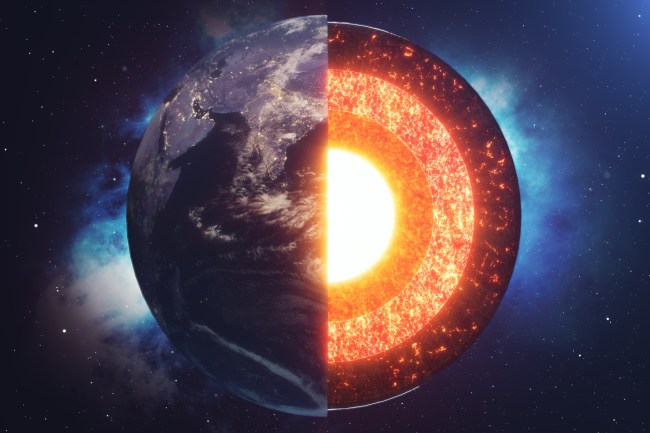
iStockphoto / Rost-9D
What is the earth’s core made of? This is a common question that humans have been asking for millenniums. A new scientific study finds that the Earth’s core is a complex mixture of superheated solid and liquid states.
Previous scientific data suggested that the Earth’s core is “made almost entirely of metal—specifically, iron and nickel.”
“Elements that dissolve in iron, called siderophiles, are also found in the core,” National Geographic previously reported. “Because these elements are found much more rarely on Earth’s crust, many siderophiles are classified as “precious metals.” Siderophile elements include gold, platinum, and cobalt.”
However, new research out of the Institute of Geochemistry at the Chinese Academy of Sciences (IGCAS) proclaims that the Earth’s core is a “superionic.”
“Superionic matter, which is somewhere between liquid and solid,” ABC News reports. “In superionic water, molecules split apart into oxygen and hydrogen atoms. It’s the iron atoms that form the 3D “solid” structure in a superionic state, and the lighter elements that flow around it like liquid.”
“We find that hydrogen, oxygen, and carbon in hexagonal close-packed iron transform to a superionic state under the IC (inner core) conditions, showing high diffusion coefficients like a liquid,” the study published in Nature suggests. “This suggests that the IC can be in a superionic state rather than a normal solid state. The liquid-like light elements lead to a substantial reduction in the seismic velocities, which approach the seismological observations of the IC20,21. The substantial decrease in shear-wave velocity provides an explanation for the soft IC21. In addition, the light-element convection has a potential influence on the IC seismological structure and magnetic field.”
Researcher and physicist He Yu at the Chinese Academy of Sciences told Newsweek, “It is quite abnormal. Our result shows that [in] the Earth’s inner core some light elements, such as carbon, hydrogen, and oxygen, behave like liquids and diffuse freely in the lattice of solid iron. This suggests that the inner core is not a normal solid but a composition of solid iron sublattice and liquid-like light elements.”
“It is very interesting that both the inner core structure and geomagnetic field have shown observable changes in the past few decades,” He said. “In this case, the core structure may change with the geomagnetic field. We have started related simulations. Hopefully, we can show our results in a short future.”
Newsweek reported, “The paper found that the superheated solids that occur in the inner core create strong convection currents, giving buoyancy for lighter elements there. These in turn float around and produce the convection currents of the outer core that drives liquid metal found there in motion and combine with the inner core to give Earth its magnetic field.”
“It is quite abnormal,” He told USA Today. “The solidification of iron at the inner core boundary does not change the mobility of these light elements, and the convection of light elements is continuous in the inner core.”
The scientific study finds “hydrogen, oxygen, and carbon in hexagonal close-packed iron transform to a superionic state” under the inner core.
“This suggests that the inner core can be in a superionic state rather than a normal solid state,” the authors assert.
ScienceAlert reports, “Superionic is another state of matter – alongside solid, liquid, and gas – but with distinct differences. In superionic water – which was recently made in a lab – extremely high temperatures and pressures break apart each water molecule, leaving the oxygen ions to form a solid, while the hydrogen ions float around more like a liquid.”